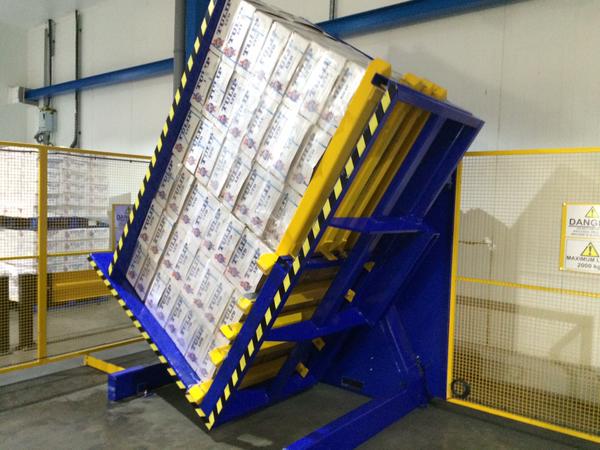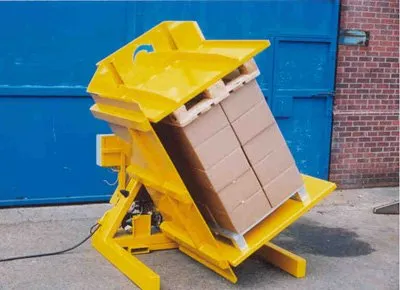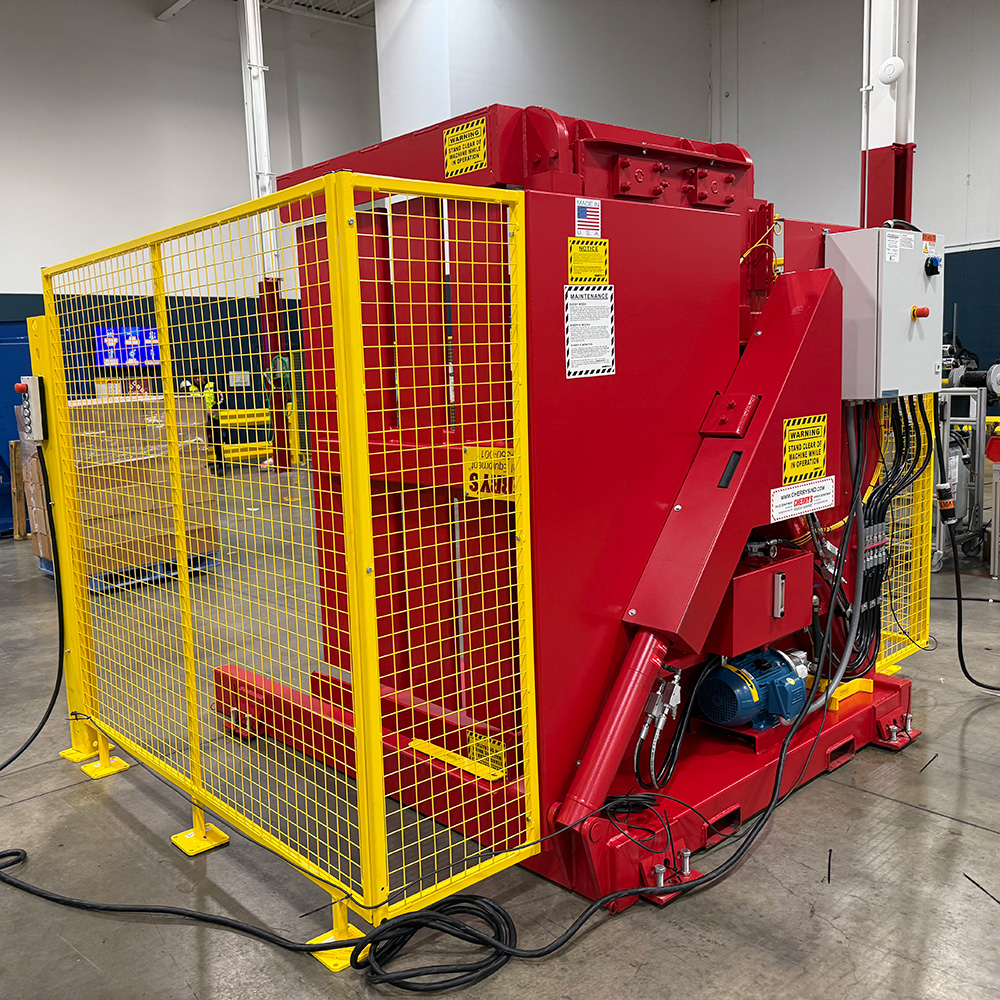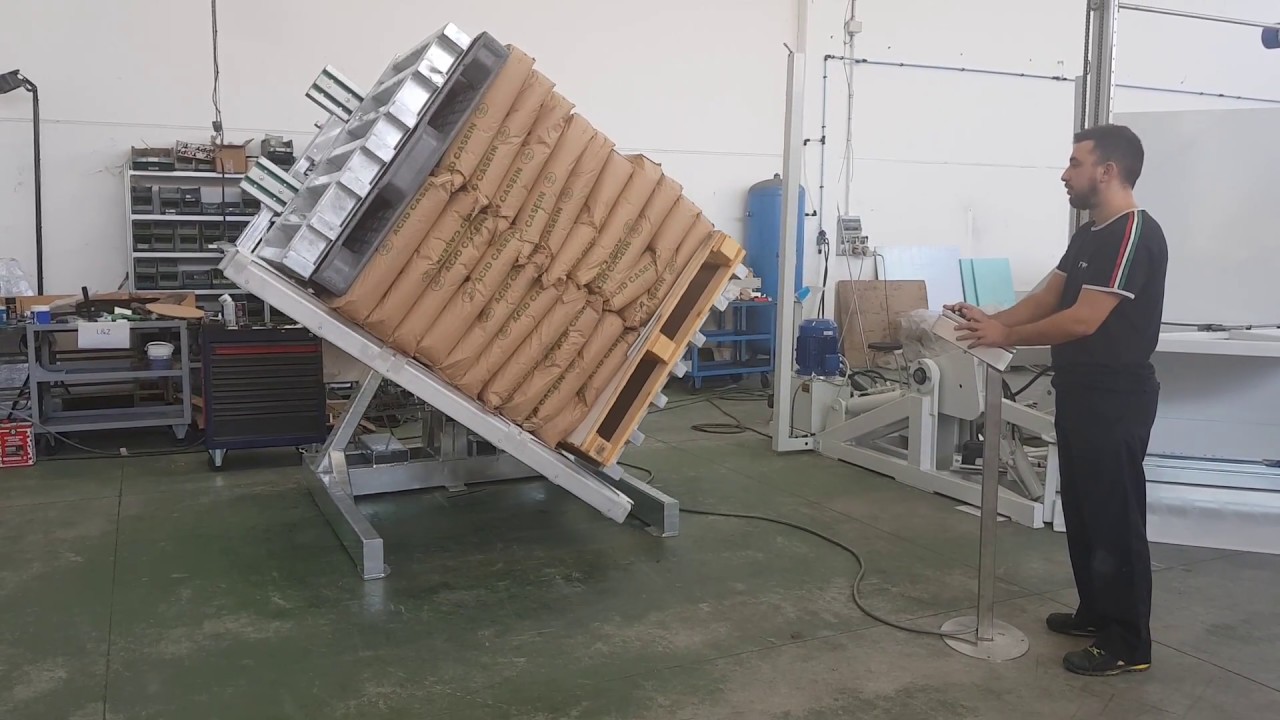Is Your India Factory Struggling with cost-effective solutions for high-volume FMCG plants? Try a Pallet Changing Machine
Your FMCG plant in India is running at full speed. Production targets are high, and the pressure is constant. But you're facing a familiar problem. Your logistics and packaging lines are struggling to keep up. You see rising labor costs, goods damaged during manual handling, and the constant worry of hygiene compliance. These issues create bottlenecks, eat into your profits, and stop you from focusing on what really matters: growing your business. It feels like you are patching leaks instead of building a stronger ship. But what if there was a single, powerful solution that could address these core challenges? There is, and it's called a pallet changing machine.
A pallet changing machine is one of the most effective solutions for high-volume FMCG plants in India looking to cut costs and boost efficiency. This equipment automates the transfer of goods from one pallet to another. This simple function has a massive impact. It dramatically reduces the need for manual labor, minimizes product damage, and speeds up the entire dispatch process. It also plays a critical role in maintaining hygiene by keeping external pallets out of your clean production zones. For any fast-moving factory in India, it's a strategic investment, not just an expense.

I've spent my entire career in the world of industrial machinery. I started on the factory floor, learning how machines work and, more importantly, how they fail. Later, I built my own factory, SHJLPACK, focusing on wrapping and handling solutions for heavy industries like steel. I learned that whether you are handling a heavy steel coil or a pallet of fragile food products, the principles of efficiency, safety, and cost-effectiveness are exactly the same. The challenges you face in your FMCG plant are universal. Let’s look deeper into how this one piece of equipment can solve so many of them.
How Can a Pallet Changer Directly Slash Operational Costs in an Indian FMCG Plant?
Are you looking at your quarterly reports and seeing operational costs slowly creeping up? You see the rising expense of labor, the budget for damaged stock, and the money spent on inefficient processes. These small numbers add up, and they directly reduce your profitability. Manual pallet handling is a huge, often invisible, part of this problem. You are paying multiple workers to do a slow, repetitive, and risky job. This manual process is a cost center you might have accepted as necessary, but it doesn't have to be. A pallet changer transforms this weak link in your supply chain into a source of savings and efficiency.
A pallet changer directly slashes operational costs in an Indian FMCG plant by targeting four key areas: labor reduction, product damage prevention, logistics acceleration, and pallet inventory optimization. By automating the pallet transfer process, you can reassign multiple workers to more valuable tasks. The machine’s gentle and controlled handling means fewer goods are dropped or crushed, cutting write-off costs. Faster transfers mean trucks are loaded quicker, improving turnaround times. Finally, it allows you to use cheap one-way pallets for shipping while keeping your expensive, high-quality pallets in-house, saving a fortune in lost assets.

When I was building my own business, every rupee counted. I had to justify every equipment purchase. I learned to look beyond the initial price tag and analyze the total cost of ownership and the return on investment. A pallet changer is a perfect example of a machine with a fast and significant ROI. Let’s break down the numbers and the hidden costs to see the full picture.
Breaking Down the Direct Cost Savings
The most obvious saving is in labor. But the numbers are often more dramatic than people think. Let's compare a manual process to an automated one. A manual pallet switch often requires two or three workers. It can take them anywhere from 5 to 10 minutes to carefully de-stack and re-stack a pallet. A pallet changer, operated by a single person, can do the same job in about 60 seconds.
Let's look at a simple calculation for a factory running one shift.
| Metric | Manual Pallet Change | Automated Pallet Changer |
|---|---|---|
| Workers Required | 2-3 | 1 |
| Time per Pallet | 8 minutes | 1 minute |
| Pallets per Hour | 7 | 60 |
| Cost Scenario | ||
| Labor Cost per Worker/Hour | ₹200 | ₹200 |
| Cost per Pallet (Labor) | ₹53 (for 2 workers) | ₹3.33 (for 1 operator) |
| Annual Savings (20 pallets/day, 300 days) | Base Cost: ₹640,000 | New Cost: ₹40,000 |
| Total Annual Labor Saving | ₹600,000 |
These numbers are conservative. If your volume is higher or you run more shifts, the savings multiply quickly. This is a direct, measurable impact on your bottom line.
Uncovering the Hidden Costs of Manual Work
Beyond direct labor, manual handling comes with hidden costs. Product damage is a major one. When workers are rushing, boxes get dropped, bags get torn, and containers get crushed. A certain percentage of product is often written off as an unavoidable cost of doing business. A pallet changer handles the entire load as a single, stable block. It reduces damage rates to nearly zero. If you are losing even 1% of your product on a high-value pallet, the savings from preventing this damage alone can be substantial.
Another hidden cost is workplace injury. Lifting heavy boxes repeatedly is a leading cause of back injuries and other musculoskeletal problems. These injuries lead to lost workdays, higher insurance premiums, and potential legal issues. Automating this heavy lifting creates a safer workplace for your employees.
Optimizing Your Pallet Fleet
Finally, let's talk about the pallets themselves. Many companies in India ship goods on high-quality, expensive wooden or plastic pallets. The problem is, you often don't get these pallets back. They are lost or damaged in transit. This is a constant drain on your resources. A pallet changer allows you to implement a pallet management strategy. You can use durable, high-quality pallets within your factory (these are called "captive pallets"). When it's time to ship, the machine quickly transfers the goods to a cheaper, one-way shipping pallet. You stop losing your most valuable assets. This simple change in process, enabled by one machine, can save thousands upon thousands of rupees every month.
Will a Pallet Changing Machine Keep Up with the Demands of a High-Volume Production Line?
Your production lines are the heart of your factory. They are finely tuned for maximum output. You measure success in units per hour. So, it's natural to worry that adding a new process at the end of the line could create a bottleneck. You have a valid concern: what happens if your packaging and dispatch area can't keep up with production? Pallets start to pile up, your warehouse gets congested, and in the worst case, you might even have to slow down or stop the production line. That's a disaster for a high-volume plant.
Yes, a modern pallet changing machine is specifically designed to meet and exceed the demands of a high-volume production line. These are not slow, standalone pieces of equipment. Fully automated pallet changers can process up to 60 pallets per hour, or one pallet every minute. They are built to integrate seamlessly with your existing conveyor systems, robotic palletizers, and stretch wrappers, ensuring a continuous and uninterrupted flow of goods from production to dispatch. This eliminates end-of-line bottlenecks and allows your plant to run at its full potential.

I remember a project in the steel industry where we had a similar challenge. The rolling mill was producing coils much faster than the old packing line could handle them. Coils were backing up, and it was costing the company a fortune in lost production time. The solution was to design an integrated line where each machine 'talked' to the next. The principles are identical for an FMCG plant. Your pallet changer shouldn't be an island; it must be a connected part of your high-speed logistics system.
Throughput Capacity: The Speed You Need
Let’s be very clear about the speed difference. A team of workers manually changing a pallet is doing well if they complete 7-10 pallets in an hour. This is often not enough for a modern FMCG line that might be producing 20, 30, or even more pallets per hour. A bottleneck is almost guaranteed.
| System | Typical Throughput (Pallets per Hour) | Consistency |
|---|---|---|
| Manual Team (2-3 workers) | 7 - 10 | Varies with fatigue |
| Standalone Pallet Changer | 15 - 25 | Consistent |
| In-line Automated Pallet Changer | 40 - 60 | Highly consistent |
As you can see, even a basic standalone machine offers a significant speed boost. A fully integrated, in-line system is designed for the highest-volume factories. It can receive a pallet from a conveyor, change it, and send the new pallet on its way to the stretch wrapper or loading dock, all without human intervention. This ensures your logistics can always keep pace with production.
Seamless Integration with Your Factory's Brain
A modern pallet changer is not just a mechanical device; it's an intelligent one. It can be fully integrated with your Warehouse Management System (WMS) or Manufacturing Execution System (MES). This means the system knows which pallet is coming, what kind of pallet it needs to be transferred to, and where it needs to go next.
This integration allows for:
- Automated routing: The WMS can direct pallets from the production line to the correct pallet changer automatically.
- Data tracking: Every pallet change is logged, giving you complete traceability.
- Reduced errors: Automation eliminates the human error of choosing the wrong pallet type or sending the product to the wrong destination.
This level of integration turns your end-of-line packaging from a simple manual process into a smart, efficient, and data-rich operation.
What Are the Key Safety and Hygiene Benefits of Using Pallet Changers in Food and Pharma?
In the FMCG sector, especially in food, beverage, and pharmaceuticals, quality is everything. A single instance of contamination can have devastating consequences for your brand and your business. You face strict regulations from bodies like the FSSAI. One of the biggest and most overlooked risks in any plant is the humble wooden pallet. Pallets that arrive from outside your factory can carry dust, moisture, bacteria, insects, and other contaminants. Bringing these directly into your clean production or packaging areas is a risk you cannot afford to take.
The most critical benefit of a pallet changer is its ability to create a physical hygiene barrier, which is essential in food and pharma. It allows you to transfer your finished goods from potentially contaminated external pallets (like wood) onto clean, sanitized in-house pallets (like plastic or aluminum) before they enter a hygiene-sensitive area. This single step dramatically reduces the risk of cross-contamination, helps you comply with standards like GMP and HACCP, and protects both your product and your brand's reputation. It also significantly improves worker safety by eliminating dangerous manual lifting.

My background is in steel, which is a tough environment. But even there, safety is paramount. We learned early on that the best way to prevent accidents is to engineer the risk out of the process. The same logic applies to hygiene. Instead of constantly fighting potential contamination, you engineer a system that prevents it from entering your facility in the first place. A pallet changer is a core part of that engineering solution for any modern FMCG factory.
Creating a Fortress of Hygiene
Think of your production area as a clean room or a fortress. You need to control everything that comes in and out. A pallet changer acts as the gatekeeper for your goods. It is typically installed at the boundary between the main warehouse and the clean production or packaging zones.
Here’s how it works:
- A forklift brings a pallet of finished goods from the production line on a clean, in-house plastic pallet.
- The pallet changer transfers the entire stack of goods onto a wooden shipping pallet.
- The clean plastic pallet never leaves the hygienic zone; it goes back to be reused.
- The goods on the wooden pallet are then moved to the dispatch area for shipping.
This process works in reverse for raw materials, ensuring that pallets from external suppliers never contaminate your storage or production areas.
| Pallet Type | Hygiene Risk | Durability |
|---|---|---|
| Wood Pallets | High (splinters, bacteria, moisture, pests) | Low to Medium |
| Plastic/Aluminum Pallets | Low (non-porous, easily washed/sanitized) | High |
By using a pallet changer to manage this transfer, you take control of your environment and make your hygiene protocols far more robust.
Compliance and Worker Safety
Meeting standards like HACCP (Hazard Analysis and Critical Control Points) and GMP (Good Manufacturing Practices) requires you to identify and control risks. Using a pallet changer is a clear, demonstrable action that shows auditors you are proactively managing the risk of contamination from incoming and outgoing pallets.
Furthermore, let's not forget about the safety of your people. A fully loaded pallet can weigh over 1,000 kg. Manually de-stacking and re-stacking these loads is physically demanding and dangerous. The risk of crushing injuries or severe back strain is always present. A pallet changer automates this entire lifting process. It is enclosed within safety caging, light curtains, and emergency stops to ensure the operator is always safe. Investing in this technology is also an investment in the health and well-being of your workforce.
How Do You Choose the Right Pallet Changer for Your Specific Indian Factory Needs?
So, you understand the benefits. You see how a pallet changer can cut costs, increase speed, and improve hygiene. The next logical question is, "Which one is right for me?" There are many different models and types on the market, from simple tippers to complex in-line systems. Making a choice can feel overwhelming. Choosing the wrong machine can be a costly mistake. You could end up with a model that is too slow for your volume, too rough on your fragile products, or too large for your factory floor.
To choose the right pallet changer for your Indian factory, you must first carefully analyze four key factors: your product characteristics, your required throughput, your pallet specifications, and your available space. You need to assess if your goods are robust or fragile, determine the number of pallets you need to process per hour, know the exact sizes and types of pallets you use, and measure the area you can dedicate to the machine. A detailed evaluation of these needs, ideally with an experienced partner, will ensure you invest in a machine that is a perfect fit for your operation, providing the best possible return.

As an engineer, this is the part of the process I enjoy most. It's like solving a puzzle. Finding the perfect machine for a specific job is incredibly satisfying. I've always believed that you shouldn't just buy a machine; you should invest in a solution. That means starting with a deep understanding of the problem. Let's walk through the key questions you need to ask.
The Four Critical Decision Factors
Before you even look at a brochure, you need to do some homework on your own operation. This information will guide your entire selection process.
| Decision Factor | Key Questions to Answer | Why It Matters |
|---|---|---|
| 1. Product Characteristics | Are my goods in sturdy boxes, or are they in bags, bottles, or vials? Are they sensitive to being tilted or compressed? | This determines the type of machine. Tilting inverters are great for robust loads, while side-clamping exchangers are better for fragile or unstable goods. |
| 2. Throughput Needs | How many pallets do I need to process per hour, both now and in the future? | This decides the level of automation. Low volume might suit a standalone machine, while high volume demands a fully integrated, in-line system. |
| 3. Pallet Specifications | What are the exact dimensions (length, width, height) of my incoming and outgoing pallets? What are they made of (wood, plastic)? | The machine must be physically able to handle all your pallet types. Non-standard pallet sizes require custom solutions. |
| 4. Factory Layout | How much floor space do I have? What is the ceiling height? Where will it be located in relation to my production and dispatch areas? | This dictates the machine's footprint and orientation. Some models are more compact than others. Safety zones around the machine also require space. |
Inverter vs. Exchanger: Understanding the Technology
Once you know your needs, you can start looking at machine types. The two most common are Pallet Inverters and Pallet Exchangers.
- Pallet Inverter (Tipper): This machine clamps the load, rotates it 180 degrees, and rests it on the new pallet. It's fast, robust, and great for stable loads like sacks of flour, boxes of components, or frozen goods. It's generally the most cost-effective option.
- Pallet Exchanger (Pusher): This machine clamps the load from the sides and gently pushes it from the old pallet to the new one, which is positioned right next to it. The load itself is never tilted. This is the ideal solution for very fragile or unstable products like glass bottles, pharmaceuticals, or stacked pails.
Finding a Partner, Not Just a Supplier
My final piece of advice is this: look for a supplier who acts like a partner. In my journey of building SHJLPACK, I learned that the best suppliers were the ones who took the time to understand my challenges. They didn't just sell me equipment; they provided a solution.
Your supplier should ask you all the questions we've discussed above. They should be interested in your product, your process, and your goals. They should offer support with installation, provide training for your operators, and have a clear plan for service and spare parts. A machine is a long-term investment. Make sure you choose a partner who will be there to support you for the long run.
Conclusion
Investing in the right pallet changing machine is a strategic move to cut costs, boost speed, and improve hygiene in your high-volume Indian FMCG plant. It is a total solution.

